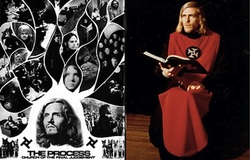
Review by Richard Metzger on Dangerous Minds
http://dangerousminds.net/comments/the_process_church_of_the_final_judgement_revelations_of_an_apocalypse_cult
http://dangerousminds.net/comments/the_process_church_of_the_final_judgement_revelations_of_an_apocalypse_cult
Review on LIVING TRADITIONS magazine
http://www.livingtraditions-magazine.com/
In the short time The Process existed it was always controversial, beginning as Compulsions Anonymous, a form of independent auditing adapted from the founders time in Scientology, it grew into one of the most unusual religious groups of the period. After some years Robert De Grimston was ejected from the organization he had helped found and it moved into more conventional religious territory, finally transforming into the large animal sanctuary network called Best Friends Animal Society with no obvious religious associations. Robert DeGrimston tried to resurrect The Process at various times after 1975 to no avail and other members and interested parties have created adaptations since but none have had the same intensity or success as the original. Since it closed it doors in 1975 it has been the subject of more rumor and slander than nearly any other organization including some outright fictional claims. There were constant attempts to link them to Charles Manson including a chapter in The Family by Ed Sanders and later discussions in The Ultimate Evil by Maury Terry, indeed it became regular fare in volumes of conspiracy theory.
This volume is not an introduction and certainly Love, Sex, Fear, Death: The Inside story of the Process Church by Timothy Wylie (Feral House) is a good place to start or the more hard to find out of print Satan’s Power by William Bainbridge (University of California Press 1978), Bainbridge uses pseudonyms to protect The Process and its members anonymity in the study. The Process Archives, Documents, Reflections and Revelations by Alessandro Papa works from source materials and offers one of the most comprehensive and unbiased records of The Process available. It is illustrated throughout with rare photos and reproductions and includes information never unearthed by any researcher before.
Papa offers an extensive history of The Process while along the way exploring the development of its theology, practise, structure and ideals. It is certainly an impressive volume which is extremely well documented and referenced. Much material on The Process lacks a critical eye and after many years of studying source materials Papa has been able to make sense of the complex world which was The Process. Papa explores likely influences on the evolution of its theology including the work of Carl Jung but also documents how it developed from being a psychological movement into a spiritual one which saw the Four Gods of the universe as ontologically real. It would be too easy to see the Four Gods in simplistic terms but Papa examines their basis in eastern and western thought as well as in psychology, alchemy and esotericism. It is fair to say that the theology of The Process echoes early forms of Gnosticism above and beyond all other traditions and Papa uses perceptive diagrams to model his understanding of The Process theology and its heritage in gnostic thought. The Four Gods Jehovah, Lucifer, Satan and Christ offer a complex theology which evolved over time and was applied on many different levels from the personal, societal to cosmological and spiritual.
One of the most unique aspects of The Process is their symbolism and Papa examines it in great detail discussing both well-known and lesser known symbols and how they developed. The section on The Process Churches publications is extensive and illustrated throughout.
Papa has clearly studied The Process teachings and practices in great detail and offers an extensive examination of all aspects of their unusual way of life from “donating” where they donate their time and energy to selling Process materials to the esoteric aspects of their teachings. This is “The Game” where the student works through Awareness, Acceptance to Control and then onto self-realisation. Papa includes liberal quotes from source material to document the various aspects of the teachings.
While much emphasis is placed on the teachings, another fascinating aspect of The Process is its hierarchy, grades, admission tests and administrative/religious structure. Papa continues to examine the fashion and look of The Process which set it apart from other spiritual organisation and indeed from the general population which it defined as grey forces, Process members also changed their names as part of their initiation.
The grey forces or normality and mediocrity are examined in detail and are similar to the Traditionalist view as found in Rene Guenon and Julius Evola of the present period as the Kali Yuga or age of iron. Such a view also resonates with the teachings of G.I Gurdjieff and P.D. Ouspensky that mankind is asleep and most die without any degree of self-realisation. The Process was a fascinating combination of extremes especially since it embraced the Four Gods and hence all the potentials of experience that which is considered darkness and light and good and evil, interests ranged from far right politics to environmentalism, social activism to both a love and contempt for humanity at the same time.
Papa gives a detail account of the internal crisis that broke The Process apart, when it's two leaders (The Omega) divorced Robert DeGrimston was removed from his role as teacher and prophet. This gave free reign to Mary Ann and the higher echelon of The Process to transform it into a more mainstream religious organisation. Robert DeGrimston’s attempts to rebuild The Process met with little success.
This is a superb and comprehensive study of The Process. It includes an astounding range of original images and the author has clearly has access to a superb collection of Process materials. There is extensive quoting of original materials and Papa offers a perceptive overview of the history of The Process as well as an insightful consideration of its complex theology in its various stages of development.
